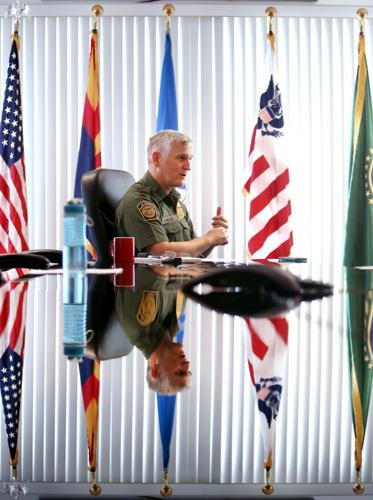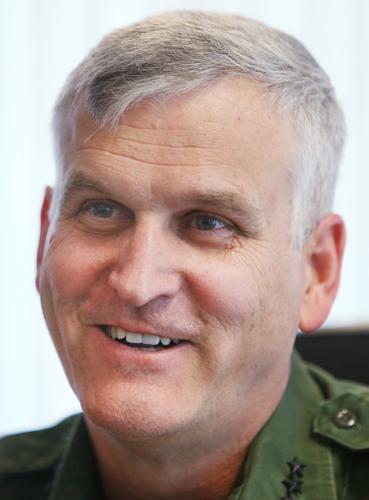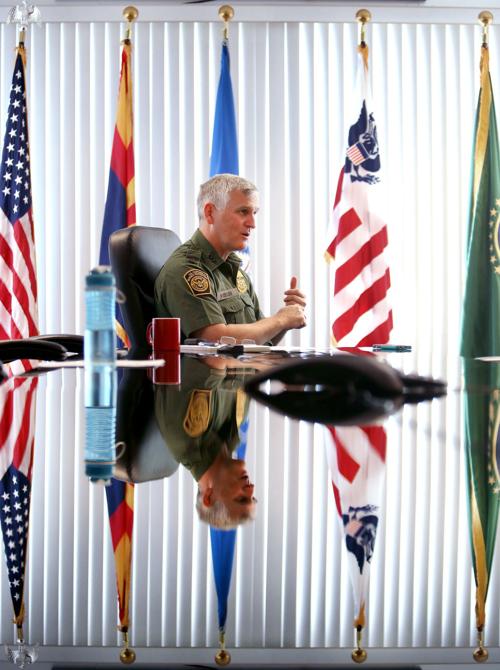With apprehensions and drug seizures down in the Tucson sector, new Border Patrol Chief Paul Beeson has a new focus: security and enforcing the law.
Last year the sector, which until recently was the busiest in the nation, made 63,000 apprehensions — the fewest since 1991.
The sector also seized less than 750,000 pounds of marijuana, after years of surpassing 1 million pounds each year.
Next-busiest was the Rio Grande Valley sector in Texas, with about 500,000 pounds of marijuana seized in fiscal 2015.
The Tucson sector covers 262 miles of the border and has about 4,000 Border Patrol agents.
The Arizona Daily Star talked with Beeson about border security and the sector. Below are excerpts from the interview:
What’s the state of the Tucson sector?
There are still some challenges along the border. We still have some areas where activity occurs but we are seeing, overall, a decrease in the activity — last year, about 63,000 arrests throughout the entire fiscal year for the sector, which is a tremendous reduction over years in the past.
What’s your focus going forward?
We want to make sure we are continuing to enforce the law and that we do so fairly and professionally, respectful of everyone’s constitutional rights.
What does a secure border look like to you?
When I think about a secure border, I think of one that is a border that is low risk, where we have good situational awareness and have the ability to respond and interdict anything that comes across the border.
Does the Tucson sector fit that definition?
We have areas of low risk, we have some areas of moderate risk, and those are going to fluctuate too. When you look at areas where we have a good layout of the technology, of personnel, things like that where activity is low, I would classify that as a low-risk area. But there are some areas we are still working on and we will continue to work on.
Where are some of those areas in this sector?
If you’ve been out along the border in Arizona it’s phenomenal in terms of the ruggedness of the terrain, the vastness of the area, and so those areas with more difficult terrain continue to be areas that we remain concerned about and it’s still that west desert area.
What needs to happen for Tucson’s numbers to remain where they are now, if not even lower?
We are going to continue to focus on our mission. When you look at the traffic here — narcotics, people — they don’t smuggle themselves. There are networks engaged in that activity that are smuggling the people, that are smuggling the narcotics. So for us to further enhance the border security situation here, we need to focus on those networks.
From where you sit right now, how can you make sure that the agents who are under you value human life and act professionally, responsibly and all the other qualities that you mention?
I go back to what this workforce is comprised of — men and women who are professional in their approach, they act with integrity, they do value human life. We do a lot of work with them to make sure we continue to reinforce those principles.
They know how to do their job and they do their job. If there’s an instance where that has not occurred, we will take the appropriate action that will get that corrected.
The agency as a whole has been widely criticized for use-of-force incidents. Any proactive measures you can take, especially as you get new agents?
We have new technology we are utilizing such as the “VirTra” (virtual training simulator) ... It’s one of those things to reinforce the use-of-force principles for us and provides the agents the opportunity, in a safe environment, to experience a use-of-force situation and then make those judgments that they would need to make. Then they have the opportunity to review that decision and look at whether or not it was the right or wrong decision.
Of the times I’ve been there, I’ve seen that they make the right decision.
Use of force is something we discuss frequently. When we have to qualify quarterly with our weapons, use of force is discussed then. It’s reviewed throughout the employee’s work life.
What’s the role of local and state agencies in the overall Border Patrol mission?
Clearly, it is an expectation of the American public that these borders be secure. It’s our primary responsibility, but it’s not just a Border Patrol concern. The immigration stuff, we are going to take care of, but the other border security issues — the narcotic trafficking, the human trafficking, the weapon smuggling, those other things that occur along the border — there are other agencies that have the ability to engage with us in attacking the networks that engage in those activities, and we are going to work with them.
Partnership for us is critical. I’ve been doing this job all across the Southwest border — Texas, Arizona, New Mexico, California — and every place I’ve been, when we have strong partnerships with the state and local law enforcement agencies, and the tribal law enforcement agencies, we are much more effective at getting an area under control.
What role do humanitarian agencies play?
I think there are things we can work on together and I look forward to the opportunity.







